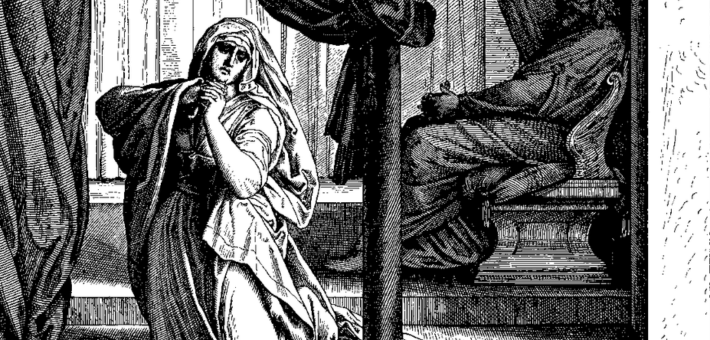Commentary on Daniel 12:1-3
Daniel 7–12 comprises an apocalyptic vision account, and these chapters are the only example of an extended apocalypse in the Hebrew Bible. The stories about Daniel are set in the sixth century BCE, a time when he serves the Babylonian king Nebuchadnezzar as an interpreter of dreams and wise counselor (see chapters 1–2; 4–6). But the author is writing much later, in the mid-second century BCE, a time in which the Jews are suffering through a severe persecution under the Seleucid king Antiochus IV, a persecution that led to the Maccabean revolt (167–160 BCE). Daniel’s visions cryptically foretell events occurring long after his own time, but they are in fact prophecy after the event.
Underlying apocalyptic narratives is the belief that earthly events are a delayed enactment of a story that is already unfolding in the heavens—as it has been in heaven, so now on earth. Daniel 12:1–3 describes (in heaven) and predicts (on earth) the final victory of God and deliverance of the faithful. “At that time” refers to a short period of unparalleled anguish on earth leading to Antiochus’s destruction by Israel’s assigned protector, the archangel Michael (see also 11:1). At the end of this war in heaven, those who “are found written in the book” are delivered—that is, those Jews who have remained faithful through the time of persecution. Those not written in the book are Jews who compromised with Antiochus’s demands.
The belief in a heavenly book that records the names of the faithful, sometimes referred to as “the book of life,” is attested elsewhere in the Bible (Psalm 69:28; Philippians 4:3; Revelation 3:5) and frequently in extracanonical Jewish literature of the time. Jews who had died prior to the final moment of deliverance foreseen by Daniel are summoned for judgment from “the dust of the earth.” This expression refers to the place of the dead, Sheol, where all people go when they die or “sleep.” Aroused from the dust, the faithful Jews will be rewarded with everlasting life and the unfaithful Jews punished with everlasting contempt.
The author focuses on the Jewish community, not all of humanity, although later readers have understood the promise/threat to apply broadly to universal resurrection and judgment.
There is likely an allusion in verses 2–3 to Isaiah 26:19. These two passages are the clearest attestation in the Hebrew Bible to an emerging belief in resurrection in the postexilic period. In addition, a special group among the righteous is singled out: “those who are wise … who lead many to righteousness” (see also 11:33). Daniel is representative of this group (1:4, 17). “The wise” in the author’s time were those who, like him, urged other Jews to be faithful to the covenant and resist the demands of Antiochus.
The specific word choices in 12:1–3 echo Isaiah 52:13 and 53:11–12. This intertextual allusion aligns “the wise” who were killed during the persecution in the author’s time with Isaiah’s suffering servant:
See, my servant shall prosper; he shall be exalted and lifted up, and shall be very high … Out of his anguish he shall see light; he shall find satisfaction through his knowledge. The righteous one, my servant, shall make many righteous, and he shall bear their iniquities.
The suffering of the faithful leaders is not merely tragic and meaningless; it leads others to faithfulness and ultimately results in the eternal glorification of the wise. The author renders this glorification in cosmic imagery. The wise who “make many righteous” shall “be exalted and lifted up” to shine like the sky-dome (raqia(, as in Genesis 1:6–7) and like the stars of heaven. They are transfigured.
In the face of the experience of exile and the suffering the Jews endured in the centuries following it, divine providence, how God manages the world, came into question. The idea that the righteous are rewarded and the wicked suffer soured as experience showed that the reverse was very often the case. This was painfully true during the persecution by Antiochus IV. The problem was acute; the righteous were suffering precisely because they were righteous. Where was God in such a time?
The apocalyptic understanding of divine providence deals with this problem by imagining history as a predetermined scheme in which evil is allowed to flourish for a set time, a time during which the righteous suffer for their faithfulness. Why? The author of Daniel says that it is to test and purify them (11:35). But more broadly, Daniel portrays the powers that oppose God’s forces in heaven and the oppressive empires that are their manifestation on earth as wielding potent and consequential anti-divine power. They must be fought and defeated by the heavenly agents of God, angelic prince against angelic prince, to bring God’s ultimate victory. In the end, all is set right, but in the present there is war and great suffering. God’s control of history is not absolute, only ultimate.
The mythic worldview of apocalypticism is problematic for many Christians today. Helpfully, Walter Wink offers an interpretive framework for understanding it (see his Naming the Powers). He suggests that the mythic depiction of warring powers helps us to identify and understand the inner (spiritual) and outer (mundane) aspects of the powers that rule the world today. The notion of heavenly powers reminds us that our battle is not merely against “enemies of blood and flesh” (Ephesians 6:12). There are indeed material forces of evil to be confronted, but there is an inner reality of oppressive forces that transcends the material and that must be recognized and confronted. Spiritual weapons are needed to confront these forces.
Martin Luther King Jr., one of “the wise” of his time, emphasized this as he prepared people to confront the powers of racism and oppression. Prayer was not a formality before a protest; it was a necessary and powerful preparation for confronting “the powers of this present darkness.”
Clergy inhabit the role of “the wise,” those to whom the “many” look for guidance in righteousness. The role is challenging. Speaking out against evil and for justice can result in social or professional death. Following the countercultural teachings of Christ Jesus often leads to conflict. Consider the demands of the Sermon on the Mount, Jesus’ call to take up the cross, his warnings about wealth and self-aggrandizement, and his parable of the final judgment in Matthew 25. The “cost of discipleship” is high, but the reward is eternal, now even as it was in the time Daniel was written.


November 17, 2024